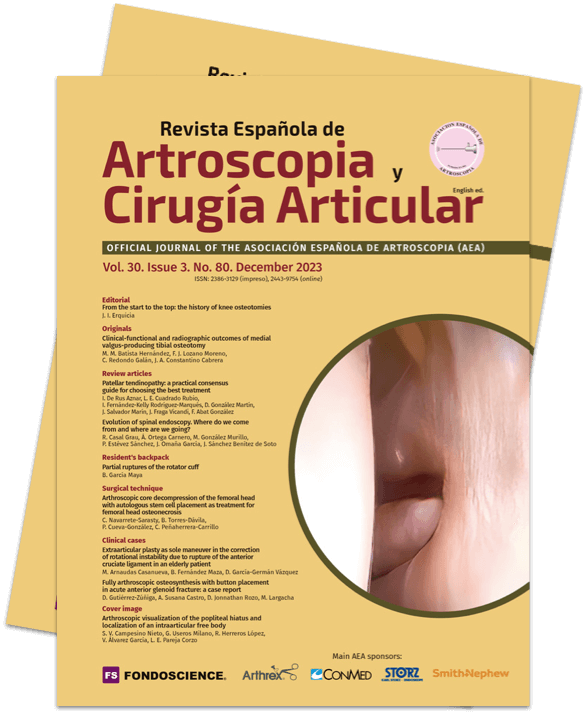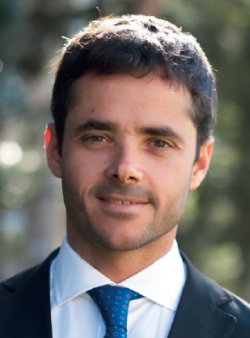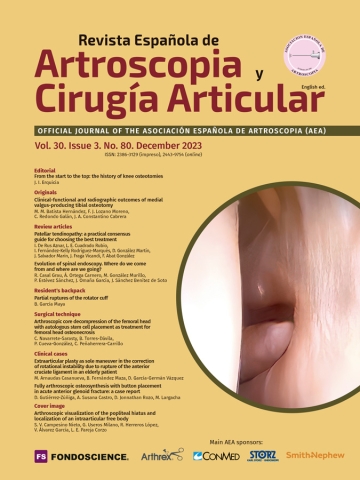Dear colleagues,
It is a pleasure for me to address you on occasion of this last issue of the year 2023 and to wish you a prosperous and healthy New Year.
In times of pandemic and geopolitical conflicts everywhere, it is valuable to remember that not only life and politics are subject to cycles, but also our profession. In this case, on examining the orthopedic cycles, we must highlight the moment of splendor being experienced by knee osteotomies, extending beyond the coronal, axial and sagittal planes, and capturing an increasingly significant space at congresses and in journals(1).
In exploring the origins of this technique, we must go back to ancient Egypt, to 1600 years B.C., when a papyrus provided the first notions on the importance of post-fracture bone alignment in order to prevent future deformities(2). Later in time, between the fifth century B.C. and the second century A.D., the Romans and Greeks made use of the hippocratic scamnum as traction device, facilitating alignment and the healing of fractures(3).
And not so long ago, in 1835, John Rhea Barton performed the first knee osteotomy, opening a new chapter in the history of orthopedic surgery(4). Sir William Macewen, in 1880, published the first book fully dedicated to osteotomy, stressing the importance of the specific materials and presenting instruments that persist to this day(5). History reminds us that "specific" osteotomes are not new.
Despite their years of splendor during much of the twentieth century, the 1970s marked the beginning of the "great recession" for osteotomies, due to the variability of indications, disparity of the surgical techniques, and consequently also variability of the results obtained(6). In those years, knee arthroplasties were on the rise, though Coventry pointed out that: “Osteotomy will remain the ideal indication in cases of symptomatic single-compartment osteoarthrosis in young patients”(7).
Names such as Gariepy, Coventry himself, Fujisawa, Miniaci, Hernigou, Paley and Noyes, among others, guided the implementation of surgical planning and the design of specific implants, evolving from the "classical" closing tibial osteotomy to the proximal opening approach. Locally, a notorious group of orthopedic surgeons has kept this technique alive during decades, strengthening the Spanish ties with the history of knee osteotomies(8,9,10).
In recent years we have witnessed renewed interest and advances in the practice of osteotomies. Innovation and good outcomes have gone together. The technique has become more safe, reliable and reproducible(11). The tendency towards individualization of the indication of the technique already causes us to miss the Fujisawa point as the gold standard, and the introduction of "new technologies", more sophisticated planning tools and individualized plates encourages us to explore new limits(12). However, science will continue to serve as our guide in determining the prudent limits.
In consideration of the above, the submission of articles focused on this topic is particularly gratifying for the REACA. We invite potential authors, regardless of their experience, to count on the REACA and its School for Authors for sharing their scientific interests and concerns. We offer them our rigorous and close assistance in this thrilling voyage into the world of research.
I hope you have an excellent experience and enjoy this new issue of our journal!
Sincerely,
Juan Ignacio Erquicia
Associate Editor of the REACA
Fundación Universitaria Althaia. Manresa
iMove. Clínica Mi Tres Torres. Barcelona (Spain)





